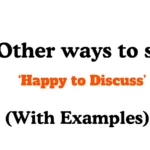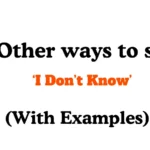Finding the right words to express empathy can make all the difference in building meaningful connections, especially in professional and personal communication. While “I am sorry to hear that” is a thoughtful response, having more alternatives allows you to respond with warmth, sincerity, and care in different contexts. Below are 30 alternative phrases, each with examples and explanations, to help you show support and compassion in your messages.
What Does “I Am Sorry to Hear That” Mean?
The phrase “I am sorry to hear that” is a way of acknowledging someone’s difficulty or bad news and offering a sense of empathy. It tells the other person that you recognize their situation and feel compassion for what they’re going through.
Is It Professional/Polite to Say “I Am Sorry to Hear That”?
Yes, it is both professional and polite. It works well in emails, conversations, and formal or informal exchanges. However, relying on it too often may feel repetitive, so having alternative expressions helps maintain freshness and sincerity.
Pros or Cons
Pros:
- Shows empathy and understanding
- Universally accepted in personal and professional contexts
- Simple and clear
Cons
- Can sound overused if repeated often
- May feel generic without personalization
Synonyms For “I Am Sorry to Hear That”
- That must be really tough for you
- I can only imagine how hard that is
- I’m here if you need someone to talk to
- I truly empathize with your situation
- That sounds really difficult
- I understand how upsetting that must feel
- My heart goes out to you
- I’m thinking of you during this time
- I’m here to support you however I can
- That must feel overwhelming
- I feel for you in this situation
- I can see why that would be upsetting
- I wish I could make things easier for you
- I understand how painful this must be
- Please know you’re not alone in this
- I really sympathize with what you’re going through
- That sounds heartbreaking
- I hope things get better soon
- I admire your strength through this
- I’m sending you my support
- That must weigh heavily on you
- I care about what you’re going through
- I’m holding you in my thoughts
- I can sense how difficult this is for you
- I respect the way you’re handling this
- I hope you find some comfort
- That must be so challenging
- I feel your pain in this situation
- I’m with you in spirit
- I wish you peace and healing
1. That must be really tough for you
Scenario: When someone shares a difficult personal or work-related challenge.
Examples:
- “That must be really tough for you, but I admire how you’re managing it.”
- “I can see how challenging this situation is. That must be really tough for you.”
- “I know things aren’t easy right now— that must be really tough for you.”
Tone: Empathetic, compassionate.
Explanation: This phrase shows you’re recognizing the difficulty of their situation without sounding dismissive.
2. I can only imagine how hard that is
Scenario: When someone confides about a loss, stress, or unexpected struggle.
Examples:
- “I can only imagine how hard that is for you and your family.”
- “That sounds overwhelming—I can only imagine how hard that is.”
- “I can only imagine how hard that is, but please know I care.”
Tone: Gentle, supportive.
Explanation: It emphasizes humility, acknowledging that you may not fully understand but are still empathetic.
3. I’m here if you need someone to talk to
Scenario: When a colleague or friend seems isolated in a tough time.
Examples:
- “I’m here if you need someone to talk to about this.”
- “Don’t hesitate—I’m here if you need someone to talk to.”
- “Whenever you feel ready, I’m here if you need someone to talk to.”
Tone: Caring, supportive.
Explanation: This offers emotional availability and invites the person to share more if they want to.
4. I truly empathize with your situation
Scenario: When acknowledging professional or personal struggles in a formal tone.
Examples:
- “I truly empathize with your situation and hope it improves soon.”
- “I want you to know that I truly empathize with your situation.”
- “I truly empathize with your situation—it must be challenging.”
Tone: Formal, empathetic.
Explanation: It’s a professional way to express genuine understanding.
5. That sounds really difficult
Scenario: When someone shares a stressful or painful experience.
Examples:
- “That sounds really difficult, and I hope things ease up for you soon.”
- “Wow, that sounds really difficult. Please know I’m here for you.”
- “That sounds really difficult—I admire how you’re handling it.”
Tone: Sympathetic, kind.
Explanation: This phrase validates their struggle and shows genuine concern without being dramatic.
6. I understand how upsetting that must feel
Scenario: When someone experiences a disappointment or setback.
Examples:
- “I understand how upsetting that must feel—you’ve put in so much effort.”
- “I understand how upsetting that must feel, but I believe things will get better.”
- “I understand how upsetting that must feel, and I’m here to listen.”
Tone: Understanding, compassionate.
Explanation: This conveys recognition of their emotional state and assures them they’re not being dismissed.
7. My heart goes out to you
Scenario: When someone is grieving or facing a personal loss.
Examples:
- “My heart goes out to you during this incredibly hard time.”
- “Please know my heart goes out to you and your family.”
- “My heart goes out to you—I wish you strength and healing.”
Tone: Gentle, compassionate.
Explanation: A deeply empathetic phrase, often used for emotional or sensitive situations.
8. I’m thinking of you during this time
Scenario: When you want to let someone know you’re keeping them in your thoughts.
Examples:
- “I’m thinking of you during this time and sending strength your way.”
- “Please know I’m thinking of you during this time of difficulty.”
- “I’m thinking of you during this time—stay strong, you’re not alone.”
Tone: Warm, supportive.
Explanation: This shows ongoing care, even if you can’t directly help.
9. I’m here to support you however I can
Scenario: When you want to actively offer help.
Examples:
- “I’m here to support you however I can—please don’t hesitate to reach out.”
- “Whatever you need, I’m here to support you however I can.”
- “I’m here to support you however I can, even if it’s just listening.”
Tone: Proactive, compassionate.
Explanation: Goes beyond empathy by showing readiness to assist practically or emotionally.
Read More:30 Other Ways to Say ‘please note’ (With Examples)
10. That must feel overwhelming
Scenario: When someone faces multiple challenges at once.
Examples:
- “That must feel overwhelming, but I admire your strength.”
- “I can imagine that must feel overwhelming—I’m here if you want to talk.”
- “That must feel overwhelming; please remember you don’t have to carry it alone.”
11. I feel for you in this situation
Scenario: When someone shares a difficult or frustrating experience.
Examples:
- “I feel for you in this situation—it must be exhausting.”
- “I feel for you in this situation, and I’m sorry you’re dealing with it.”
- “I feel for you in this situation—you’ve been through a lot.”
Tone: Sympathetic, warm.
Explanation: Expresses emotional connection while showing care without sounding overly dramatic.
12. I can see why that would be upsetting
Scenario: When someone is clearly distressed about something that happened.
Examples:
- “I can see why that would be upsetting—it’s not an easy thing to face.”
- “I can see why that would be upsetting, especially after all your effort.”
- “I can see why that would be upsetting; I would feel the same.”
Tone: Validating, compassionate.
Explanation: Acknowledges their emotions as valid, helping them feel understood.
13. I wish I could make things easier for you
Scenario: When someone is overwhelmed and you want to show care.
Examples:
- “I wish I could make things easier for you, but I’ll do whatever I can.”
- “I wish I could make things easier for you—please lean on me if needed.”
- “I truly wish I could make things easier for you during this time.”
Tone: Caring, heartfelt.
Explanation: Conveys deep concern and a willingness to help.
14. I understand how painful this must be
Scenario: When someone is going through grief or heartbreak.
Examples:
- “I understand how painful this must be—I’m so sorry you’re experiencing it.”
- “I understand how painful this must be, but please know you’re not alone.”
- “I understand how painful this must be; take things one step at a time.”
Tone: Gentle, empathetic.
Explanation: Validates emotional pain and shows compassion.
15. Please know you’re not alone in this
Scenario: When someone feels isolated while struggling.
Examples:
- “Please know you’re not alone in this—I’m here to stand by you.”
- “Please know you’re not alone in this; I’m thinking of you.”
- “Please know you’re not alone in this—lean on me if you need support.”
Tone: Reassuring, supportive.
Explanation: Offers comfort by reminding them they have support.
16. I really sympathize with what you’re going through
Scenario: For a professional or formal way to acknowledge hardship.
Examples:
- “I really sympathize with what you’re going through and hope it eases soon.”
- “I really sympathize with what you’re going through—please take care of yourself.”
- “I really sympathize with what you’re going through; you have my support.”
Tone: Professional, kind.
Explanation: A respectful way to show understanding, especially in formal settings.
17. That sounds heartbreaking
Scenario: When someone shares something truly sad or devastating.
Examples:
- “That sounds heartbreaking—I’m so sorry you’re experiencing this.”
- “That sounds heartbreaking; please know I care deeply.”
- “That sounds heartbreaking, and I hope you find comfort soon.”
Tone: Deeply empathetic, gentle.
Explanation: Strong acknowledgment of pain, best for serious emotional situations.
18. I hope things get better soon
Scenario: When you want to add encouragement along with empathy.
Examples:
- “I hope things get better soon—you deserve peace and happiness.”
- “I’m sorry you’re going through this. I hope things get better soon.”
- “I truly hope things get better soon—stay strong.”
Tone: Hopeful, supportive.
Explanation: Offers a balance of empathy and encouragement for the future.
19. I admire your strength through this
Scenario: When someone is handling hardship with resilience.
Examples:
- “I admire your strength through this—you inspire those around you.”
- “I admire your strength through this challenge, even when it’s not easy.”
- “I admire your strength through this—you’ve handled it with grace.”
Tone: Encouraging, respectful.
Explanation: Focuses on their resilience, providing positive reinforcement.
20. I’m sending you my support
Scenario: When you want to show emotional presence despite distance.
Examples:
- “I’m sending you my support during this challenging time.”
- “Please know I’m sending you my support and positive thoughts.”
- “I’m sending you my support—you’re not facing this alone.”
Tone: Warm, caring.
Explanation: A way to show solidarity even if you can’t physically help.
21. That must weigh heavily on you
Scenario: When someone is under pressure or carrying emotional weight.
Examples:
- “That must weigh heavily on you—I hope you’re taking care of yourself.”
- “I can see that must weigh heavily on you; please know I’m here to help.”
- “That must weigh heavily on you—remember you don’t have to do this alone.”
Tone: Thoughtful, validating.
Explanation: Recognizes the seriousness of their burden and encourages self-care.
22. I care about what you’re going through
Scenario: When you want to show heartfelt concern directly.
Examples:
- “I care about what you’re going through and want to support you.”
- “Please know I care about what you’re going through.”
- “I truly care about what you’re going through—don’t hesitate to reach out.”
Tone: Honest, supportive.
Explanation: A direct way to show genuine compassion and concern.
23. I’m holding you in my thoughts
Scenario: When you can’t be there physically but want to show care.
Examples:
- “I’m holding you in my thoughts during this hard time.”
- “Please know I’m holding you in my thoughts and sending strength.”
- “I’m holding you in my thoughts—you are not forgotten.”
Tone: Gentle, compassionate.
Explanation: A warm way to show that you’re thinking about them.
24. I can sense how difficult this is for you
Scenario: When someone is visibly struggling or expressing pain.
Examples:
- “I can sense how difficult this is for you—I truly empathize.”
- “I can sense how difficult this is for you, and I wish things were easier.”
- “I can sense how difficult this is for you—please don’t go through it alone.”
Tone: Observant, empathetic.
Explanation: Shows attentiveness to their feelings and validates them.
25. I respect the way you’re handling this
Scenario: When someone demonstrates strength despite hardship.
Examples:
- “I respect the way you’re handling this—it shows great courage.”
- “I respect the way you’re handling this challenge—it’s not easy.”
- “I respect the way you’re handling this with resilience and grace.”
Tone: Respectful, encouraging.
Explanation: Focuses on their positive qualities, uplifting their spirit.
26. I hope you find some comfort
Scenario: When someone is grieving or in deep sorrow.
Examples:
- “I hope you find some comfort during this difficult time.”
- “I hope you find some comfort in knowing you’re supported.”
- “I truly hope you find some comfort and peace soon.”
Tone: Gentle, compassionate.
Explanation: Offers a wish for peace and healing without overstepping.
27. That must be so challenging
Scenario: When someone is overwhelmed by work, family, or personal issues.
Examples:
- “That must be so challenging—you’ve been balancing so much.”
- “I know that must be so challenging; I admire your persistence.”
- “That must be so challenging—remember, it’s okay to ask for help.”
Tone: Empathetic, validating.
Explanation: Acknowledges the complexity of their struggle and offers reassurance.
28. I feel your pain in this situation
Scenario: When you want to connect on a deeply personal level.
Examples:
- “I feel your pain in this situation and wish I could ease it.”
- “Please know I feel your pain in this situation.”
- “I feel your pain in this situation—you’re not going through it alone.”
Tone: Deeply empathetic, personal.
Explanation: Communicates strong emotional solidarity with the person.
29. I’m with you in spirit
Scenario: When you can’t be physically present but want to show solidarity.
Examples:
- “I’m with you in spirit, even if I can’t be there right now.”
- “I’m with you in spirit and sending all my support.”
- “Please know I’m with you in spirit—you’re not alone.”
Tone: Comforting, supportive.
Explanation: Reassures the person that they are emotionally supported despite distance.
30. I wish you peace and healing
Scenario: When someone is enduring grief, loss, or emotional pain.
Examples:
- “I wish you peace and healing during this hard time.”
- “I wish you peace and healing—you deserve rest and comfort.”
- “From my heart, I wish you peace and healing.”
Tone: Gentle, heartfelt.
Explanation: Offers compassionate wishes for recovery and emotional strength.
Conclusion
Expressing empathy goes beyond simple words—it’s about making someone feel seen, heard, and supported. While “I am sorry to hear that” is kind, these 30 alternatives provide ways to show warmth, sincerity, and care in a way that feels more personal and meaningful. Whether you’re consoling a colleague, a friend, or a loved one, choosing the right words helps build trust, compassion, and stronger connections.

Emma Brooke is a passionate advocate for effective communication and language mastery. As a dedicated professional in the field of grammar and writing, Emma brings a wealth of knowledge and expertise to those seeking to improve their linguistic skills. With a focus on clarity, precision, and style, Emma Brooke is committed to helping individuals refine their language use to communicate confidently and effectively.













